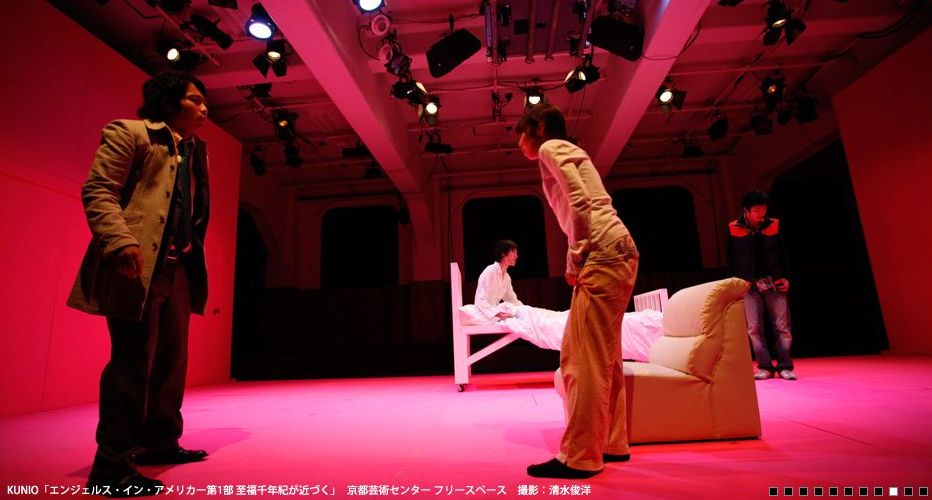Strategies and structures from Asian dance festivals
 In March 2011, I received an email from Fumi Yokobori, director of Dance Box, a non-profit organisation based in Kobe, Japan.
In March 2011, I received an email from Fumi Yokobori, director of Dance Box, a non-profit organisation based in Kobe, Japan.“We would like to have a meeting in Kobe to introduce case studies from dance festivals in Asia and to build a network among festival directors. This will be a reference program for our Kobe-Asia Contemporary Dance Festival to be held in February 2012. Please check the program details below.”
The meeting Fumi proposed, entitled ‘Case Studies #1: Performing Arts Festivals in Asia’, was only 3 weeks away. But who could turn down a trip to Japan? So at the beginning of April I found myself arriving on a fresh spring day in Kansai, Japan's cultural and industrial heartland. Later I met the other international participants of the meeting: Jayachandran Palazhy, from the Attakkalari Biennale in Bangalore, India, and Myra Beltran, director of the WiFi Body Festival in the Philippines.
Local participants of the meeting were Hisashi Shimoyama from the Kijimuna Festa in Okinawa, Yusuke Hashimoto from the avant-garde Kyoto Experiment, and Fumi Yokobori herself, who produced the Kobe-Asia Contemporary Dance Festival in 2009-2010 at Dance Box. As the only producer in the room without a festival under my belt (the renascent MyDance Festival is coming up in September 2011) I was the one with the fewest strategies to share, and the most to learn.
The reasons for the precipitate scheduling soon became clear. Most Japanese government funding is confirmed every year in April, so each spring Japanese arts organisations like Dance Box must rush to put their programs into practice. One of the aims of this meeting was to find a way to become less dependent upon the limitations of government funding by looking at other examples outside the Japanese arts arena. Therefore, in the case studies presenters were invited to share strategies, structures, successes and failures of our festivals with an audience of our peers.
Dance Box, Kobe: Connecting New Artists to New Audiences
[caption id="attachment_12897" align="alignleft" width="437" caption="NPO Dance Box"]
The tiny 3-person Dance Box organisation started in 2001. Its early events showcased work by local artists, but later events focused on the creation of new works in residency at their 120-seat theater, leased from the City of Kobe. Although threatened by limitations of space, budget, sustainability and cash flow, Dance Box has managed to encourage the creation of new work by new artists, and to expand the audience for contemporary dance.
Dance Box emphasises small events, to encourage deeper communication between the artists and the audience. A number of international choreographers have been invited to Dance Box to present their work as well as to run workshops or create new work with dancers and non-dancers in the community. To overcome budget restrictions, Dance Box has attempted co-productions with artists from Hong Kong and Tokyo, to share the budget burden. Knowing the difficulty of traveling overseas to see the works of new artists elsewhere, Dance Box made available an archive of all its former shows on its website. It has also conducted community dance mapping exercises, working with non-contemporary dancers in the local community to help them document the distribution of dance practice in the city.
Kijimuna Festa, Okinawa: A Successful Regional Network
[caption id="attachment_12900" align="alignright" width="444" caption="Kijimuna Festa, Okinawa, Japan"]
 [/caption]
[/caption]The Kijimuna Festa in Okinawa gives young people the opportunity to see out of the eyes of artists from around the world, most of whom work in non-verbal forms of physical theatre. But Okinawa, located on a tiny island midway between the main Japanese islands and Taiwan, is so remote that travel is expensive and getting artists to the city is a real challenge.
The 7-year old Festa has overcome some of its difficulties by becoming part of the Asian Alliance of Theatre for Young Audiences. Under the auspices of the International Theatre Institute, this network helps to share the cost of bringing artists in from faraway regions, and also helps to present a more united front to international funding agencies. Representatives of the network meet twice a year to decide groups to invite and the schedule of all the festivals. The meetings are rotated around the various host organisations, who provide accommodation but not airfare.
Coordinating schedules for such a network, however, has not been easy. The Kijimuna Festa conformed with the desires of other members to hold their festivals during the northern summer, although this is uncomfortably close to the April funding line. The northern summer is also peak tourist season in Okinawa, making transport and accommodation more expensive.
However producer Hisashi Shimoyama is sanguine about the success of his event and of its supporting network. His suggestions to others interested in starting similar networks is simple: start small and stay focused.
Kyoto Experiment: Local Networks across Disciplines
The Kyoto Experiment has also triumphed through the use of a network, albeit a local, not an international one. The event ran for a month in 2010, and included many experimental interdisciplinary events, with associated symposiums and lectures. Yusuke Hashimoto, the young program director, worked with a number of other core members, all arts organisations in the city of Kyoto, who provided their own venues for the festival events. This network enabled him to secure an enormous amount of support from funding organisations, which constituted a significant chunk of Kyoto's total budget for the performing arts.
The Kyoto Experiment was able to do this because its interdisciplinary focus overcame disciplinary boundaries between arts organisations. It also reached out to the large student population in Kyoto, the 'soft brains', in Hashimoto's words, who both have an 'undisciplined' understanding of performing arts and are a promising target audience.
Attakkalari Biennale, Bangalore: Finding the Right Funder
Another interdisciplinary event, the Attakkalari Biennale, offspring of the Attakkalari Centre for Movement Arts in Bangalore, India, is also a success story. Over ten years old, the festival boasts a large program, supported by impressive infrastructure, funding and audience. Three full-time staff are employed year-round just for the festival, with others engaged around the festival season.
[caption id="attachment_12912" align="aligncenter" width="576" caption="Attakkalari Biennale, Bangalore, India"]
 [/caption]
[/caption]Artistic director Jayachandran Palazhy describes how the festival was once so badly burned by private sponsors who failed to cough up promised funds that it has now decided to depend entirely upon public money. Bangalore is the technology capital of India. Understanding that contemporary arts appeal to the young cosmopolitan audience upon whom Bangalore's technology miracle depends, the local government has been sympathetic and generous. The last biennale, for example, opened with a lavish dinner and site specific performances for an audience of 500 at the National Gallery.
Never one to rest on his laurels, Palazhy now imagines taking this model beyond Bangalore, by creating a mobile theatre that travels to regional areas displaying the works nurtured by the Biennale.
WiFi Body Festival, Manila: Changing Shape with Changing Allegiances
Myra Beltran is another energetic crusader for the arts, operating on the premise that artists should help other artists. Ten years ago, she headed small-scale events by independent contemporary dance makers. Then she accepted an offer to team up with the Cultural Center of the Philippines (CCP), to create a collaborative event linking mainstream and independent dance in Manila. The WiFi Body Festival was born, emphasizing flexibility, increased access to dance, technology, and new ways of connecting.
WiFi started in 2006 as a four-day festival with workshop and performances. The CCP gave the organisers the use of its venues and free reign to curate. For a few years the festival steadily increased its critical mass, although it provided no income for its organisers. Later the CCP provided greater subsidies, including payment for festival staff. Although this move had obvious advantages in terms of professionalisation, it made WiFi dependent on CCP patronage.
A funding fiasco during the fourth festival also convinced the organisers, now incorporated as Contemporary Dance Network Philippines (CDNP), that they should and could only manage a smaller festival. CDNP then decided to continue WiFi outside the CCP, although the CCP negotiated a temporary compromise using CCP and other alternative venues. This year, however, the CCP has decided to continue the festival without the involvement of the CDNP, unavoidably prompting disputes over ownership of the festival and its name.
The example of the WiFi Body Festival touches on various recurring themes from the ‘Case Studies #1’ meeting. Funding bodies, both public and private, are alternately seen by festival directors as enabling and disempowering. Smaller and voluntary models offer the personal touch and greater flexibility, but larger better-funded professional institutions achieve projects of greater scale and sustainability. Networks provide solutions in some ways, but introduce complications in others.
These competing pressures and changing environments require festival creators to start with a very clear idea of their festival's purpose, whether for young people or new audiences, by diving deep into individual artists or spreading wide across disciplines, and by treading the road alone or joining hands with others. Encouragingly, judging by the diversity of the gathering at Case Studies #1, there seem to be as many solutions as there are challenges.
Bio of the writer
Bilqis Hijjas produces, choreographs, performs, conducts residencies for choreographers, lectures and writes about dance in Kuala Lumpur, Malaysia. She is the president of MyDance Alliance, the Malaysian chapter of World Dance Alliance – Asia-Pacific. As the artistic director of the upcoming MyDance Festival, she is excited by the opportunity to mobilise a volunteer team armed with minimal government funding to showcase the breadth and depth of contemporary dance in Malaysia in September this year.
Links
Dance Box organization: http://www.db-dancebox.org/
Kijimuna Festa in Okinawa: http://www.kijimunafesta.com/
Asian Alliance of Theatre for Young Audiences: https://www.facebook.com/pages/ATYA-Asian-Alliance-of-Theatre-for-Young-Audiences/146443515389042
The Kyoto Experiment: http://kyoto-ex.jp/
Attakkalari Biennale: http://www.attakkalaribiennial.org/
Cultural Center of the Philippines (CCP): http://www.culturalcenter.gov.ph/
Contemporary Dance Network Philippines (CDNP): http://www.contempodancenetphil.org
Similar content
posted on
05 Apr 2023
from - to
24 Jul 2023 - 30 Jul 2023
posted on
06 Sep 2010
from - to
02 Nov 2011 - 12 Nov 2011








